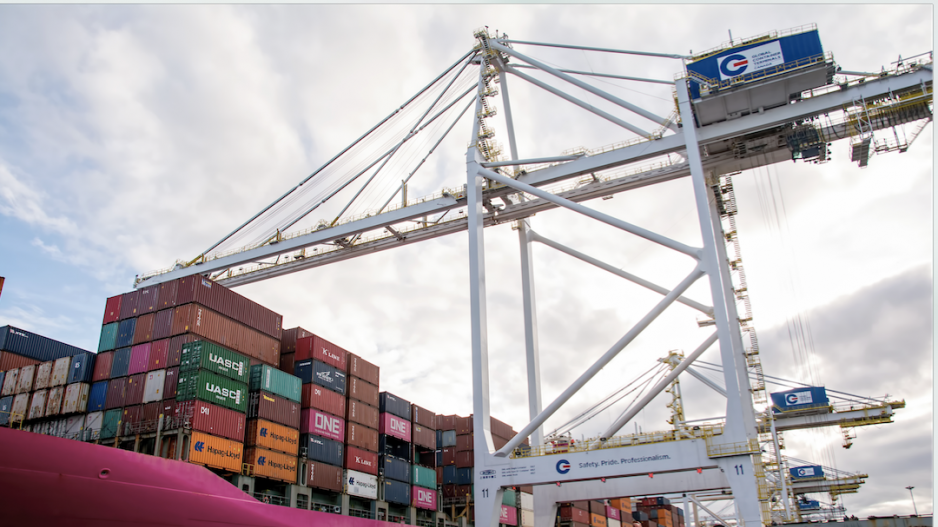It will be all hands on deck to keep container shipping companies in B.C. and elsewhere around the world from taking on water in the COVID-19 storm.
The devastating disruption to trade and the subsequent shock to global economies in 2020’s first half will have a lasting impact on how ocean carriers ride out the bad weather created by the global pandemic.
Some might not make it.
So say analysts from U.K.-based shipping consultancy Drewry.
In a May 14 market update, company research managers Philip Damas and Simon Heaney mapped out forecasts as best they and their company could for the container shipping sector in what are uncharted waters.
The weather report was not good.
Heaney, Drewry’s senior manager of container research, said second-quarter 2020 container port throughput is projected to drop an estimated 16% compared with the same time last year, and the company’s revised baseline overall outlook for 2020 has global container cargo handling down 8%.
“And that would be the worst performance since the financial collapse of 2009.”
It might also be an optimistic view.
Heaney noted that a scenario in which the pandemic lingers deep into 2020 and is followed by another outbreak in 2021 would result in a 12% drop in container traffic this year followed by another 6% decline in 2021.
“Such an outcome,” Heaney said, “could have very grave implications for the container industry and would certainly require more radical surgery beyond the industrial scale of blank [cancelled] sailings we are currently witnessing.”
That radical surgery from a prolonged downturn, he added, “would undoubtedly raise the risk of a major carrier bankruptcy, and in this nightmare scenario we would expect to see mass idling of ships and staff reductions.”
That could have serious consequences for companies like Seaspan Corp. The Vancouver-based company is the world’s largest lessor of container ships.
Its customers include major container carriers such as COSCO; Yang Ming Marine, which reported a US$27 million loss in 2020’s first quarter; and the Ocean Network Express (ONE) shipping alliance.
Drewry’s Z score financial metrics, which are used to assess how close a container carrier company is to slipping into bankruptcy, noted that eight of the 11 global container carriers assessed were in the Z score’s financial distress zone.
Only three, according to Damas, were relatively secure.
The last time a global container shipping company went bankrupt was in 2016, when South Korea’s Hanjin Shipping Co. sank in receivership.
At the time, Seaspan had three container ships chartered to Hanjin on the hook for approximately US$18.6 million in past-due accounts receivable from the South Korean company.
Seaspan, which now operates under holding company Atlas Corp. (NYSE:ATCO), generates most of its revenue from long-term container ship charters.
It posted operating earnings of US$687 million on revenue of US$1.13 billion in 2019, and, according to Atlas Corp.’s first-quarter 2020 financial results, the company remains bullish on Seaspan’s prospects for 2020, despite grim global economic outlooks.
It increased Seaspan’s revenue guidance for the year to between US$1.18 billion and US$1.22 billion from US$1.17 billion and US$1.19 billion. The company also noted that all 123 ships in Seaspan’s fleet have secured long-term charters.
Damas, Drewry’s managing director in charge of logistics practice, noted that Drewry’s Z scores were based on financial data from the end of 2019.
“So as we move into the current market downturn, these Z scores will deteriorate. Therefore we should not [discount] the possibility that one of the weaker carriers could reach Hanjin-type levels and disappear.”
Damas added that the 8% projected drop in global container volume represents a revenue reduction of approximately US$18 billion for the container carrier sector.
He also noted that several other issues are threatening to seriously disrupt container shipping. They include the challenge of repatriating seafarers whose employment contracts with ships have expired but cannot return to their home bases because of international travel restrictions.
If those crew members or their unions do not agree to contract extensions, ships will be under-manned and considered unseaworthy. That will force more cancelled sailings and further disrupt global trade and supply chains.
Heaney said most forecasters agree that economies in western countries will be hit hardest by COVID-19. But he added that predicting the path for the global economy in the face of such a “black swan” event as the pandemic is extremely difficult “when you don’t have a historical precedent.”
“Apologies to anyone who is craving certainty and precision, but right now we can really only talk in terms of broad scenarios and probability. I don’t think I would trust anybody who says they can confidently predict what is going to happen.” •
@timothyrenshaw




